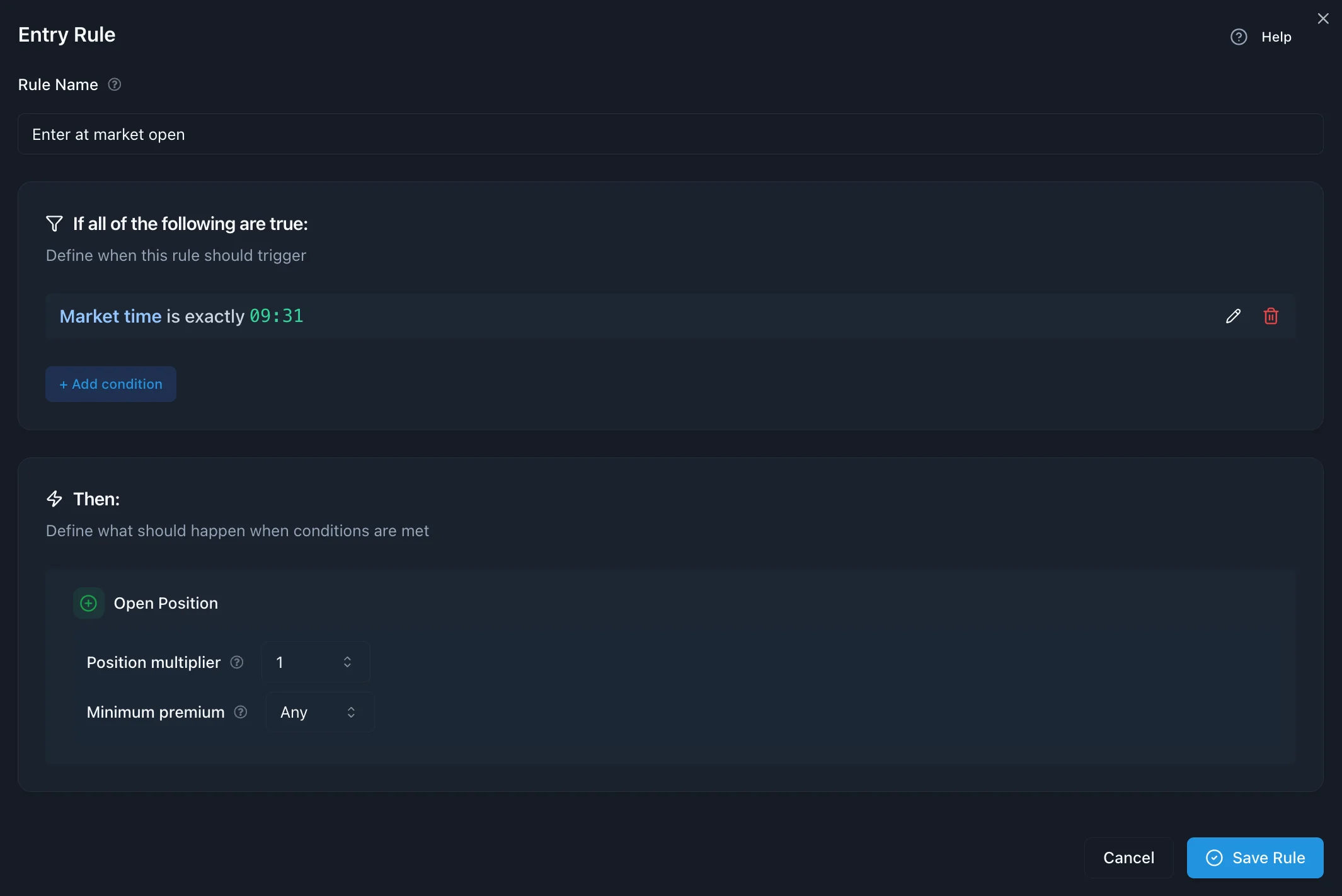3 of 5
5 min read
Entry and Management Rules Overview
When to enter, exit, and adjust positions
Entry and Management Rules Overview
Rules are the core building blocks of your trading strategy in GreeksLab. A rule combines conditions (when something should happen) with an action (what should happen) to create automated trading logic.
Understanding Rules
What is a Rule?

A rule consists of two main components:
- Conditions - The criteria that must be met (e.g., "VIX > 20" or "Time = 9:31 AM")
- Action - What happens when conditions are satisfied (e.g., "Open Position" or "Close Position")
Rule Formula: IF (ALL conditions are true) THEN (execute action)
⚠️ Important:
All conditions in a rule must be true for the action to trigger.
💡 Example:
Rule Example:
- Condition: Time equals 9:31 AM AND VIX > 20
- Action: Open Iron Condor Position
- Result: Position opens automatically when both conditions are true
Types of Rules
GreeksLab supports two main types of rules:
Entry Rules
- Purpose: Control when new positions are opened
- Action: Opens a position based on your position template
- Timing: Evaluated continuously during market hours
- Example: "Open position at 9:31 AM when VIX > 20"
Management Rules
- Purpose: Control when existing positions are modified or closed
- Actions: Close position, roll a leg, or close specific legs
- Timing: Evaluated for each open position
- Example: "Close position when profit reaches $100"
Condition Types
GreeksLab offers two ways to create conditions:
Preset Conditions
- Pre-built condition templates for common scenarios
- Easy-to-use dropdown selections and input fields
- Examples: Market Time, VIX Level, Position Profit
- Best for: Beginners and standard trading setups
Custom Expressions
- Advanced condition building using mathematical expressions
- Full access to engine data fields and complex AND/OR logic
- Best for: Advanced users with specific requirements
💡 Example:
Custom expressions can handle complex logic like "(VIX > 30 AND Time > 14:00) OR Position Loss > $500"
Actions Overview
Actions define what happens when rule conditions are satisfied:
- Open Position: Creates new position from template
- Close Position: Exits existing position
- Close Legs: Exits specific position legs
- Roll Position: Adjusts a leg to new strike
How Rules Work
Rule Evaluation
Rules are evaluated based on their conditions:
- All conditions must be true for the rule action to trigger
- Preset conditions use simple AND logic (all must be satisfied)
- Custom expressions can use complex AND/OR logic within a single condition
- Rules are evaluated continuously during simulated market hours
💡 Example:
Rule Examples:
- Simple: "Time = 9:31 AND VIX > 20" → All conditions must be true
- Complex: "(Time = 9:31 OR Time = 10:31) AND VIX > 20" → Custom expression with OR logic
Best Practices
Entry Rules
- Start simple: Begin with basic time-based entry rules
- Add filters gradually: Layer in market condition filters
- Test thoroughly: Validate rule logic works as expected
- Avoid over-fitting: Don't make entry conditions too restrictive
Management Rules
- Always include stop loss: Protect against large losses
- Set profit targets: Don't let winners turn into losers
- Use time-based exits: Avoid holding positions indefinitely
- Layer multiple rule types: Combine profit, loss, and time-based management
Next Steps
Ready to dive deeper? Explore these related topics:
- Conditions - Detailed guide to available condition types
- Actions - Complete reference for position actions and their parameters
Or return to the Strategy Building Guide to see how rules fit into the complete strategy framework.
On This Page
Last updated: 10/28/2025